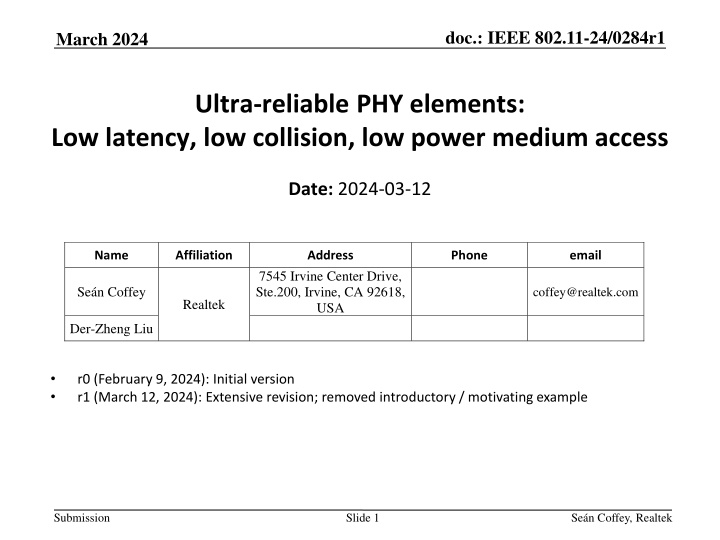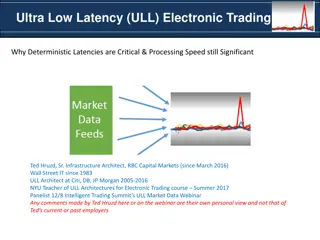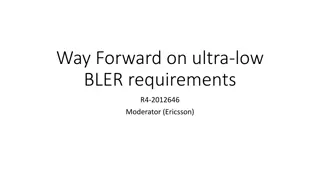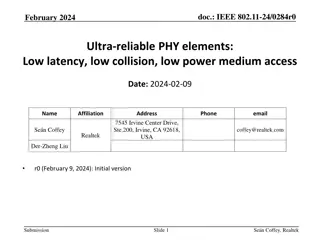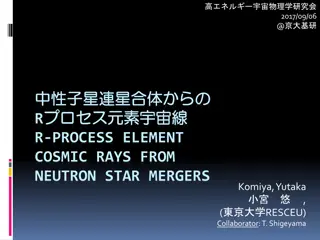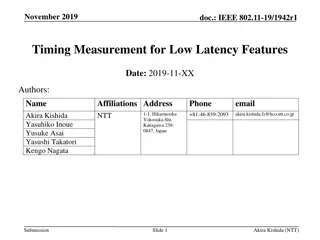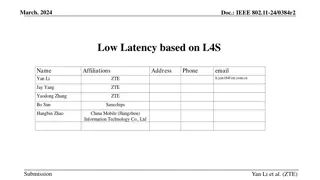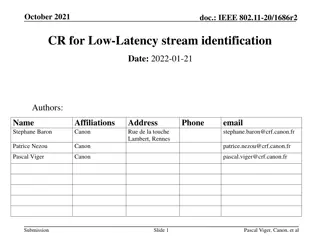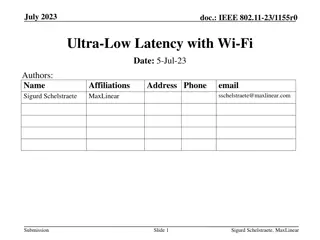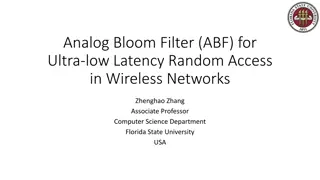Ultra-reliable PHY Elements for Low Latency Medium Access
This presentation delves into the design problem of ultra-reliable PHY elements aiming for lower latency, reduced packet loss, and improved energy efficiency in medium access scenarios. It explores optimized building blocks to ensure efficient medium access, reliable transmissions, and minimal interference even at low power levels and in the presence of co-channel devices.
Download Presentation

Please find below an Image/Link to download the presentation.
The content on the website is provided AS IS for your information and personal use only. It may not be sold, licensed, or shared on other websites without obtaining consent from the author.If you encounter any issues during the download, it is possible that the publisher has removed the file from their server.
You are allowed to download the files provided on this website for personal or commercial use, subject to the condition that they are used lawfully. All files are the property of their respective owners.
The content on the website is provided AS IS for your information and personal use only. It may not be sold, licensed, or shared on other websites without obtaining consent from the author.
E N D
Presentation Transcript
doc.: IEEE 802.11-24/0284r1 March 2024 Ultra-reliable PHY elements: Low latency, low collision, low power medium access Date: 2024-03-12 Name Affiliation Address Phone email 7545 Irvine Center Drive, Ste.200, Irvine, CA 92618, USA Se n Coffey coffey@realtek.com Realtek Der-Zheng Liu r0 (February 9, 2024): Initial version r1 (March 12, 2024): Extensive revision; removed introductory / motivating example Submission Slide 1 Se n Coffey, Realtek
doc.: IEEE 802.11-24/0284r1 March 2024 Abstract UHR has many goals and themes; lower latency; higher throughput for some SINRs; reduced packet loss; improved energy efficiency [1]. Ideally, all these objectives should be addressable by common methods. It is therefore useful to investigate optimized universal building blocks. For all the UHR themes above, it is useful to add methods for STAs: to access the medium efficiently (quickly, and without collisions), outside the scope of pre-scheduled agreements, and to complete transmissions reliably (low or no loss due to interferers), even at greatly reduced transmit power levels. This presentation approaches this design problem from the PHY viewpoint. It is possible to design optimized and universal building blocks that achieve all the above goals, even when many devices cannot hear some or even most transmissions. Submission Slide 2 Se n Coffey, Realtek
doc.: IEEE 802.11-24/0284r1 March 2024 UL medium access I Uplink medium access, without pre-negotiated schedule, basic issues: AP1 AP2 STA1, low transmit power (say 0 dBm) transmits to 4 SS AP STA1 Co-channel devices are also listening and competing Diverse group of devices, often listening with only 1 SS, and spatially scattered STA1 must hold all such devices off the air Slide 3 Submission Se n Coffey, Realtek
doc.: IEEE 802.11-24/0284r1 March 2024 UL medium access II Uplink medium access, without pre-negotiated schedule, time view: STA1 wins contention Co-channel STAs process STA1 s preamble independently Unless all such STAs defer, STA1 s transmission suffers interference Co-channel STAs are typically 2 SS devices, listening with 1 SS Co-channel STAs distributed spatially, will receive STA1 at varying Rx powers, some low AP STA1 UL PPDU STAn Interferer ( Indirect collision ) Interference is very likely if deployment is dense STA1 s best case scenario requires reducing rate significantly to overcome interference Other STAs suffer interference from STA1, and also usually have significantly reduced rate STA1 may be unable to achieve any meaningful communication, even if otherwise within range Not just a latency problem it s an interference, power, rate and connectivity problem as well Slide 4 Submission Se n Coffey, Realtek
doc.: IEEE 802.11-24/0284r1 March 2024 UL medium access III Situation is much better if AP knows STA1 wishes to transmit AP polls STA1 AP reserves medium, polls/triggers STA1 AP Tx power >> STA1 s Perhaps a 30dB difference AP is intended receiver, so is ideally placed to protect transmission STA1 transmits (SU or MU) In dense deployment, there is still likely to be some other STA that transmits somewhere, but it will probably be farther from the AP AP STA1 UL PPDU STAn (Defers) STAm Interferer With event-driven uplink traffic, STA1 s main problem is the initial step of informing the AP that it wishes to transmit now Submission Slide 5 Se n Coffey, Realtek
doc.: IEEE 802.11-24/0284r1 March 2024 UL medium access IV The basic scenario, another view: AP STA1 UL PPDU STAn Interferer ( Indirect collision ) With strong interference, AP detects only beginning of PPDU With dense deployment, AP may detect only a few slots worth All is not lost! AP has an indication that some STA wants to transmit but then it would be much better if STA1 transmitted the bare minimum and then stopped less interference for everyone else, less wasted power for STA1 Submission Slide 6 Se n Coffey, Realtek
doc.: IEEE 802.11-24/0284r1 March 2024 UL medium access V The basic scenario, another view, contd: AP 8 s STS 8 s LTFs 4 s L-SIGData STA1 UL PPDU 9 s 9 s 9 s STAn Interferer 4 s ( Indirect collision ) Everything after the first 4 s is designed for making this PPDU succeed at the first attempt 4 s is enough to signal presence of the STA E.g., The start of a valid OFDM transmission shall cause CS/CCA to detect a channel busy condition with a probability >90% within 4 s for 20 MHz channel spacing , 18.3.10.6, REVme D5.0 p. 2037 Submission Slide 7 Se n Coffey, Realtek
doc.: IEEE 802.11-24/0284r1 March 2024 UL medium access VI 4 s signals indicate interest in transmitting but do not seize the medium: 4 s STA1 STA1 contends as usual in EDCA Transmits in its normal slot Transmits only 4 s half short training Does not change EDCA states 4 s STAn (Intended) AP gains medium access later AP AP might then: Poll some known high priority STAs, or Utilize UORA, or Seek further information, or, Do any of the above after a delay, Direct collision between 4 s and a regular PPDU? No worse than if STA1 sent full PPDU Direct collision between multiple 4 s signals? Looks like composite 4 s signal AP needs to identify STA(s) anyway or some combination of the above, etc. No direct collision Success: side information sent for free Submission Slide 8 Se n Coffey, Realtek
doc.: IEEE 802.11-24/0284r1 March 2024 UL medium access VII This building block can be used far beyond the basic scenario: Can be iterated to enable fast, scalable identification of STAs STA1 time STA2 AP1 4 s half short training Poll for 4 s signal in window 4 s response (4 s slots) Poll for slot 6 STA2 transmits PPDU Submission Slide 9 Se n Coffey, Realtek
doc.: IEEE 802.11-24/0284r1 March 2024 UL medium access VIII Same procedure works even if done piece by piece STA1 STA2 AP1 (Delay) (Delay) (Repeatable) This permits scalable, efficient identification of STAs (Minimizing the duration is critical 4 s blocks open the door to many uses) Slide 10 Submission Se n Coffey, Realtek
doc.: IEEE 802.11-24/0284r1 March 2024 UL medium access IX Summary of PHY and MAC attributes: MAC STA1 Enables unsolicited high priority medium access by STAs to send initial device present signal STA2 No need to rely on APs to arrange polls, or to await polls Use only as needed no overhead due to polls with no response AP1 Any number of STAs can transmit in one slot Received power of STA transmissions can be very low Rx power, AP detects 4 s AP decodes data from STA other STAs decode preamble << PHY << Submission Slide 11 Se n Coffey, Realtek
doc.: IEEE 802.11-24/0284r1 March 2024 Coordinated medium access Multiple APs could use to coordinate low-interference medium access E.g., Multiple APs (same or different ESS) collaborate, e.g., by rotating chair AP role Chair AP coordinates by soliciting 4 s half short trainings from STAs with traffic Responses do not have to be from STAs associated with that AP For example, BSS can be denoted by slot Chair AP can then allocate time-shared TxOPs Enables low transmit power devices, by facilitating no-interference operation No need for chair AP to decode data from STAs of other APs only needs to detect STS No advance agreement is necessary Coordinated medium access with connectionless, zero state operation Fully anonymized operation STAs send only fully generic transmissions outside ESS Submission Slide 12 Se n Coffey, Realtek
doc.: IEEE 802.11-24/0284r1 March 2024 Notes Reuse and reassembly Framework enables fast detection, with many applications Fast detection even with very low / widely different received powers, many STAs Losses due to indirect collisions are minimized Elements of detection, identification, and data transmission are decoupled Timing of elements and relative timing of different elements are easily adjusted Framework also enables fast signaling of a small number of bits E.g., AP signals choice of a small number of possibilities by location of 4 s signal Testing It s straightforward to check that devices detect lone 4 s s standalone PHY test Optimized modular units that can be tested separately ease testing requirements Interoperability testing requirements are now a major bottleneck for industry adoption Submission Slide 13 Se n Coffey, Realtek
doc.: IEEE 802.11-24/0284r1 March 2024 UHR in one sentence Focus and theme: What is UHR , in one sentence? Tying compelling idealized goals to concrete layer 1-2 IEEE 802.11 elements will promote successful deployment and accelerate adoption of the eventual Wi-Fi program. Better still: having goals, methods, and solutions that are capable of being measured and demonstrated. UHR achieves ultra-high reliability by minimizing or eliminating collisions and tightly managing interference, achieving ( among others ) minimum latency and maximum energy efficiency. The framework outlined here fits the theme of ultra-high reliability and links the theme to tangible elements of basic IEEE 802.11 design. Submission Slide 14 Se n Coffey, Realtek
doc.: IEEE 802.11-24/0284r1 March 2024 Conclusion A framework has been outlined that allows STAs: to access the medium efficiently (quickly, and without collisions), outside the scope of pre-scheduled agreements, and to complete transmissions reliably (low or no loss due to interferers), even at greatly reduced transmit power levels. using adaptations of basic IEEE 802.11 channel access and detection methods. The basic PHY elements are scalable and adaptable, and can support many different new functionalities. In addition to the fundamental usefulness of these goals, they fit the theme of ultra-high reliability. Submission Slide 15 Se n Coffey, Realtek
doc.: IEEE 802.11-24/0284r1 March 2024 References 1. P802.11bn PAR , September 21, 2003: cf. https://development.standards.ieee.org/myproject-web/app#viewpar/14476/10639. 2. Doc. IEEE 802.11-23/0092r0, Preemption , J. Fang et al. 3. Doc. IEEE 802.11-23/1174r0, TXOP preemption follow up , K. Ryu et al. 4. Doc. IEEE 802.11-23/1192r0, Overlapped indication to support preemption , D. Verenzuela et al. 5. Doc. IEEE 802.11-23/1229r1, Preemption for Low Latency Application (follow up) , J. Fang et al. 6. Doc. IEEE 802.11-23/1242r0, Considerations on Inter-PPDU based Preemption Scheme , J. Moon et al. 7. Doc. IEEE 802.11-23/1886r3, Preemption techniques to meet low-latency (LL) targets , G. Chisci et al. 8. Doc. IEEE 802.11-24/0102r0, TXOP Level Preemption for Low Latency Application , J. Fang et al. Submission Slide 16 Se n Coffey, Realtek
